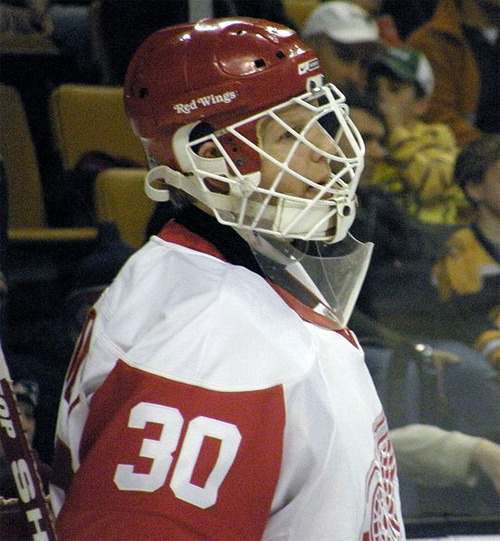The Accidental Hall of Famer

In March of 1999, my future bride treated me to a hockey game, in which my beloved Detroit Red Wings were taking on the San Jose Sharks. (My future bride’s willingness to take me to hockey games was not why I married her, but it was certainly an argument in her favor.) The game — a rather forgettable 2-0 defeat for the Forces of Good at the hands of those teal-wearing upstarts — is perhaps best remembered for this happening. But I choose to remember it for a different reason.
I was not the only Wings fan in attendance that night. Sitting behind us was a young lady who was especially… devoted in her support of the Red Wings in general and one player in particular.
“We love you, Chris Osgood,” this lady would shriek loudly, proudly, repeatedly, whenever the puck arrived in the vicinity of the Detroit netminder.Â
It was a curious expression of devotion, and not just because Osgood wasn’t in goal for that particular game. (Norm Maracle got the start instead.) No — this display of passion struck me as odd because if there’s one person who seemingly never generated much in the way of passionate outbursts during his 17-year career, it would be Chris Osgood.
I’m not saying Red Wing fans didn’t feel a certain amount of fondess for the goalie. “He was known in Detroit by his nicknames ‘Ozzie,’ chanted by the crowd after a big save,” his Wikipedia entry reads, and if there’s one thing I’ve learned in my time, it’s never to dispute anything Wikipedia says. But jot down a list of the best goalies in hockey from when Osgood entered the league in 1993 to when he retired this past Tuesday, and I bet it will take you some time before you remember to put Chris Osgood’s name on the list.
Certainly, the Red Wings seemingly had a hard time remembering just how good Chris Osgood was. Here’s a partial list of goaltenders that team management thought would handle the job better than Osgood during his 14 seasons in Detroit: Tim Cheveldae, Bob Essensa, Mike Vernon, Bill Ranford, Manny Legace, Dominik Hasek, Ty Conklin, and Jimmy Howard. So far as I can tell, Osgood was only a finalist for the Veznia Trophy once—the 1995-96 season when he lost to Jim Carrey, doubtlessly on the strength of the latter’s performance in Batman Forever. He was named to the All-Star team three times — not bad, but certainly not far short of the resumé you’d expect from a Martin Brodeur or a Patrick Roy. Osgood played in an era when NHL players competed in the Olympics; Team Canada never really gave him a sniff for a spot on the squad. Even his gear was nondescript — in an era where goalies put on customized masks depicting everything from cartoon mascots to recreations of Picasso’s Guernica, Osgood wore what looked like a standard hockey helmet with a faceguard that appeared to have been fastened on five minutes before the puck dropped.
And yet… Chris Osgood retires with 401 career wins. Only nine other goalkeepers won more than 400 games, and the only one who isn’t enshrined in the Hall of Fame — that’d be Brodeur — isn’t eligible yet. Osgood’s name has been carved onto the Stanley Cup three times, and only once was he an innocent bystander. He played in every postseason game in the Wings’ 1998 run to the Cup, and he took over for an inconsistent Hasek in the 2008 playoffs. If Sidney Crosby’s Pittsburgh Penguins teammates hadn’t of bailed out their over-rated pretty-boy captain in 2009, Osgood might have had another Stanley Cup triumph to his name.
We’d all like to be Martin Brodeur — indisputably the best at what we choose to do in life. More often than not, we fall far short of our dreams. And at the end of the day, maybe the best we can hope for is to put in our best effort, to maybe rise above the level of our talent on our best day, and — when it’s time to finally leave the stage— to be able to look back at what we’ve done with no small measure of pride. Chris Osgood can do that. He wasn’t the best of his era, but he was pretty damn good.
And if nothing else, Detroit Red Wings fans can appreciate him for this.
The Red Wings and the Colorado Avalanche squared off in a particularly nasty playoff series in 1996, sparking off a rivalry for the next few years that occasionally veered into madness. In the mid-to-late ’90s, I’m not sure that there was anything — hell, ignorance, certain ex-girlfriends — that I hated more than Colorado Avalanche. And the sight of Chris Osgood pummeling Patrick Roy like a Montreal steak always brings a smile to my face.
Frankly, I think the city of Detroit should erect a statue commemorating that moment. Put it right next to the one of Joe Louis’ fist.
[Image courtesy of Dan4th Nicolas]
